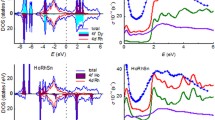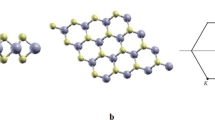Abstract
The band structures of bulk transition metal dichalcogenides ReS2 and ReSe2 are presented, showing the complicated nature of interband transitions in these materials, with several close-lying band gaps. Three-dimensional plots of constant energy surfaces in the Brillouin zone at energies near the band extrema are used to show that the valence band maximum and conduction band minimum may not be located at special high symmetry points. We find that both materials are indirect gap materials and that one must be careful to consider the whole Brillouin zone volume in addressing this question.
Article PDF
Similar content being viewed by others
Avoid common mistakes on your manuscript.
References
K.S. Novoselov, D. Jiang, F. Schedin, T.J. Booth, V.V. Khotkevich, S.V. Morozov, and A.K. Geim, PNAS 102, 10451 (2005).
J.A. Wilson and A.D. Yoffe, Adv. Phys. 18, 193 (1969).
J.-W. Jiang, Front. Phys. 10, 287 (2015).
S. Manzeli, D. Ovchinnikov, D. Pasquier, O.V. Yazyev, and A. Kis, Nat. Rev. Mater. 2, 17033 (2017).
M. Rahman, K. Davey, and S.-Z. Qiao, Adv. Funct. Mater. 27, 1606129 (2017).
H.J. Lamfers, A. Meetsma, G.A. Wiegers, and J.L. deBoer, J. Alloys Compd. 241, 34 (1996).
S. Tongay, H. Sahin, C. Ko, A. Luce, W. Fan, K. Liu, J. Zhou, Y.S. Huang, C.H. Ho, J.Y. Yan, D.F. Ogletree, S. Aloni, J. Ji, S.S. Li, J.B. Li, F.M. Peeters, and J.Q. Wu, Nat. Commun. 5, 3252 (2014).
D. Wolverson, S. Crampin, A.S. Kazemi, A. Ilie, and S.J. Bending, ACS Nano 8, 11154 (2014).
E. Canadell, A. LeBeuze, M.A. El Khalifa, R. Chevrel, and M.H. Whangbo, J. Am. Chem. Soc. 111, 3778 (1989).
M. Gehlmann, I. Aguilera, G. Bihlmayer, S. Nemšák, P. Nagler, P. Gospodarič, G. Zamborlini, M. Eschbach, V. Feyer, F. Kronast, E. Młyńczak, T. Korn, L. Plucinski, C. Schüller, S. Blügel, and C.M. Schneider, Nano Lett. 17, 5187 (2017).
J. L. Webb, L.S. Hart, D. Wolverson, C.Y. Chen, and J. Avila, M.C. Asensio, Phys. Rev. B 96, 115205 (2017).
L.S. Hart, J.L. Webb, S. Dale, S.J. Bending, M. Mucha-Kruczynski, D. Wolverson, C.Y. Chen, J. Avila, and M.C. Asensio, Sci. Rep. 7, 5145 (2017).
D. Biswas, A.M. Ganose, R. Yano, J.M. Riley, L. Bawden, O.J. Clark, J. Feng, L. Collins-Mcintyre, M.T. Sajjad, and W. Meevasana, Phys. Rev. B 96, 085205 (2017).
P. Giannozzi, S. Baroni, N. Bonini, M. Calandra, R. Car, C. Cavazzoni, D. Ceresoli, G.L. Chiarotti, M. Cococcioni, I. Dabo, A. Dal Corso, S. de Gironcoli, S. Fabris, G. Fratesi, R. Gebauer, U. Gerstmann, C. Gougoussis, A. Kokalj, M. Lazzeri, L. Martin-Samos, N. Marzari, F. Mauri, R. Mazzarello, S. Paolini, A. Pasquarello, L. Paulatto, C. Sbraccia, S. Scandolo, G. Sclauzero, A.P. Seitsonen, A. Smogunov, P. Umari, and R.M. Wentzcovitch, J. Phys. Condens. Mater. 21, 395502 (2009).
G. Kresse and D. Joubert, Phys. Rev. B 59, 1758 (1999).
A. Dal Corso, Comput. Mater. Sci. 95, 337 (2014).
J.P. Perdew and A. Zunger, Phys. Rev. B 23, 5048 (1981).
J.P. Perdew, K. Burke, and M. Ernzerhof, Phys. Rev. Lett. 77, 3865 (1996).
H.J. Monkhorst and J.D. Pack, Phys. Rev. B 13, 5188 (1976).
J.L. Webb, L.S. Hart, D. Wolverson, C. Chen, J. Avila, and M.C. Asensio, Phys. Rev. B 96, 115205 (2017).
C.H. Ho, Y.S. Huang, P.C. Liao, and K.K. Tiong, J. Phys. Chem. Solids 60, 1797 (1999).
E. Liu, Y. Fu, Y. Wang, Y. Feng, H. Liu, X. Wan, W. Zhou, B. Wang, L. Shao, and C.-H. Ho, Nat. Commun. 6, 6991 (2015).
H. Zhao, J. Wu, H. Zhong, Q. Guo, X. Wang, F. Xia, L. Yang, P. Tan, and H. Wang, Nano Res. 8, 3651 (2015).
K. Dileep, R. Sahu, S. Sarkar, S.C. Peter, and R. Datta, J. Appl. Phys. 119, 114309 (2016).
W. Wen, Y. Zhu, X. Liu, H.P. Hsu, Z. Fei, Y. Chen, X. Wang, M. Zhang, K.H. Lin, F.S. Huang, Y.P. Wang, Y.S. Huang, C.H. Ho, P.H. Tan, C. Jin, and L. Xie, Small 13, 1603788 (2017).
J.P. Echeverry and I.C. Gerber, Phys. Rev. B 97, 075123 (2018).
A. Arora, J. Noky, M. Drüppel, B. Jariwala, T. Deilmann, R. Schneider, R. Schmidt, O. Del Pozo-Zamudio, T. Stiehm, A. Bhattacharya, P. Krüger, S.M. de Vasconcellos, M. Rohlfing, and R. Bratschitsch, Nano Lett. 17, 3202 (2017).
C.H. Ho, Y.S. Huang, K.K. Tiong, and P.C. Liao, Phys. Rev. B 58, 16130 (1998).
I. Gutierrez-Lezama, B.A. Reddy, N. Ubrig, and A.F. Morpurgo, 2D Mater. 3, 045016 (2016).
S.J. Zelewski and R. Kudrawiec, Sci. Rep. 7, 15365 (2017).
Acknowledgements
This work was supported by the Centre for Graphene Science of the Universities of Bath and Exeter and by the Engineering and Physical Sciences Research Council EPSRC (UK) under Grants Nos. EP/G036101, EP/M022188, and EP/P004830; S.M.G. and L.S.H. are supported by the Bath-Bristol Centre for Doctoral Training in Condensed Matter Physics, Grant No. EP/L015544. Associated experimental studies were supported by the award of beam time at the DIAMOND (IO5) and SOLEIL (ANTARES) synchrotron beam lines and by EPSRC Grant No. EP/P004830/1. Computational work was performed on the University of Bath’s High Performance Computing Facility. Data created during this research are freely available from the University of Bath data archive at https://doi.org/10.15125/bath-00331, https://doi.org/10.15125/bath-00332.
Author information
Authors and Affiliations
Corresponding author
Rights and permissions
Open Access This article is distributed under the terms of the Creative Commons Attribution 4.0 International License (http://creativecommons.org/licenses/by/4.0/), which permits unrestricted use, distribution, and reproduction in any medium, provided you give appropriate credit to the original author(s) and the source, provide a link to the Creative Commons license, and indicate if changes were made.
About this article
Cite this article
Gunasekera, S.M., Wolverson, D., Hart, L.S. et al. Electronic Band Structure of Rhenium Dichalcogenides. J. Electron. Mater. 47, 4314–4320 (2018). https://doi.org/10.1007/s11664-018-6239-0
Received:
Accepted:
Published:
Issue Date:
DOI: https://doi.org/10.1007/s11664-018-6239-0




